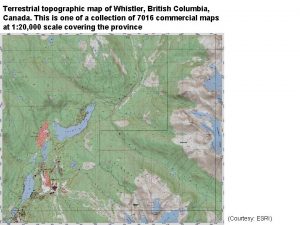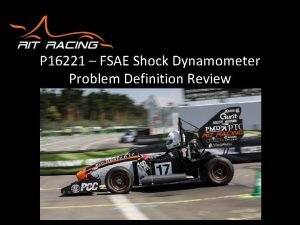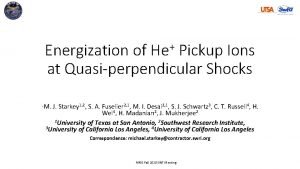Whistler precursor waves at quasiperpendicular shocks Ahmad Lalti


![Example shock event: Shock parameters: n (in GSE) [0. 84 0. 5 0. 23] Example shock event: Shock parameters: n (in GSE) [0. 84 0. 5 0. 23]](https://slidetodoc.com/presentation_image_h/9657dd5b8eea00dccfb2ec63510a000d/image-3.jpg)



- Slides: 6

Whistler precursor waves at quasiperpendicular shocks. Ahmad Lalti 1, 2, Yuri Khotyaintsev 1, Daniel Graham 1, Andris Vaivads 3, Andreas Johlander 4, Roy Torbert 5, Barbara Giles 6, Chris Russell 7, and Jim Burch 8 1 Swedish Institute of Space Physics, Uppsala, Sweden 2 Department of Physics and Astronomy, Uppsala University, Uppsala, Sweden 3 Space and Plasma Physics, School of Electrical Engineering and Computer Science, KTH Royal Institute of. Technology, Stockholm, Sweden 4 Department of Physics, University of Helsinki, Finland 5 University of New Hampshire, Durham, USA 6 NASA Goddard Space Flight Center, Greenbelt, USA 7 University of California, Los Angeles, USA 8 Southwest Research Institute, San Antonio, USA © Authors

Introduction: The interaction between waves and particles, is proposed to be one of the main mechanisms for energy dissipation at collisionless shocks. A particular type of waves that’s believed to play a major role in shock dynamics are whistler waves. They fall in a frequency range that allows interactions with both electrons and ions, making them important for energy transfer between the two species. They are also of dispersive character, which allows them to run upstream of the shock and interact with the solar wind beam heating it before reaching the shock. The exact role of those whistler in shock dynamics is still under investigation. And this was the motivation of the following project, to further explore the effect of whistle waves on quasi-perpendical collisionless shocks using data from the magnetospheric multiscale (MMS) spacecrafts.
![Example shock event Shock parameters n in GSE 0 84 0 5 0 23 Example shock event: Shock parameters: n (in GSE) [0. 84 0. 5 0. 23]](https://slidetodoc.com/presentation_image_h/9657dd5b8eea00dccfb2ec63510a000d/image-3.jpg)
Example shock event: Shock parameters: n (in GSE) [0. 84 0. 5 0. 23] 82 o 3. 25 Ellipticity B (n. T) B power spectrum Lower hybrid frequency Degree of polarization planarity E power spectrum

Spacecraft separation and instrumentations on board of MMS spacecrafts are suitable to fully characterize the observed waves. Wave normal vector and phase velocity calculated from 4 spacecraft timing and from minimum variance for successive time intervals in the whistler region. Vphase [Km/s] K components Kz Kx Resulting orientation of K in the shock coordinates Ky Using the above method we can, to very high confidence, get the following characteristics of the observed waves. 77 [Km] 401 [Km/s] 40 o Fobserved 5. 57 [Hz] Doppler Shift -3. 4 [Hz] Fplasma frame 8. 97 [Hz]

Source of the waves: Next step is to explore the source of these waves, which will allow us to further understand what role they play in the energetics of the shock From the reduced distribution function in the normal direction we can see a clear reflected ion component on top of the incoming solar wind beam. In Wu 83 it was shown that an incoming ion beam and a reflected ion beam on top of a stationary electron beam is unstable under certain plasma conditions, and can generate oblique whistler waves.

Summary •











